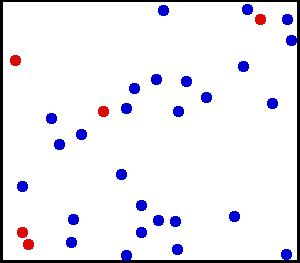T = 1 / ((R * p(rho)) / P) / M, where
T = temperature at planetary surface in Kelvins (absolute temperature),
R = Ideal Gas Law constant (explained below),
p(rho) = density of atmosphere at planetary surface,
P = pressure of atmosphere at planetary surface,
M = mean molecular weight of atmosphere at planetary surface.
The reason I call this equation odd when presented as a model for planetary temperature should be obvious from the complete absence of any inclusion of solar radiance. As we all learned in elementary school, or should have learned, the sun is the primary source of heat for all bodies in the solar system. So how can equation which completely omits this factor possibly be regarded as a temperature model?
Another oddity is that the equation is restricted to bodies possessing atmospheres of 10^5 pascals pressure or higher. This is the surface pressure of Earth's atmosphere, so the restriction not includes all solar system bodies lacking substantial atmospheres (e.g., the Moon, Mercury, Ganymede, Pluto, etc.) but also the planet Mars, the surface pressure of which is only about 7 * 10^2 pascals. One should wonder what makes Mars different? There is, in fact, a straightforward answer to this question, which is quickly revealed once the true meaning of the equation is exposed.
Skeptical science should not be confused with, or used as justification for, bad science. Most of you are probably familiar with the Ideal Gas Law, which relates the pressure, volume, number of moles, and temperature of an "ideal gas", and serves as a model of gas behavior under specified conditions; if not, a full explanation can be found at https://en.wikipedia.org/wiki/Ideal_gas_law. There you will discover the so-called Ideal Gas Law equation:
PV = nRT, where
P = the pressure of the gas,
V = the volume of the gas,
n = the number of moles of the gas (a mole being an Avagadro's number number of anything, in this
case molecules of gas, approximately 6.022×1023.
R = the constant of proportionality, having the value of 8.314 J/(K·mol),
T = the temperature (in Kelvins) of the gas.

The temperature of an ideal monatomic gas is proportional to the average kinetic energy of its atoms. The size of helium atoms relative to their spacing is shown to scale under 1950 atmospheres of pressure. The atoms have a certain, average speed, slowed down here two trillion fold from room temperature.
(From https://en.wikipedia.org/wiki/Kinetic_theory_of_gases)
(From https://en.wikipedia.org/wiki/Kinetic_theory_of_gases)
I raise the Ideal Gas Law, and its associated equation, because, as it turns out, the "model" equation for planetary temperature given above is not a model at all but merely the gas law equation algebraically rearranged:
PV = nRT
T = (P * V) / (n * R)
T = (P * V * M) / ( n * M * R)
as (n * M) / V = gas density
T = (P * M) / (p(rho) * R)
T = 1 / ((R * p(rho)) / P) / M
The equation does not work well for Mars because its atmosphere is almost pure CO2 at cold temperatures; CO2 deviates significantly from an ideal gas, as do all gasses at low enough temperatures.
For a better model, though simple, of solar system body atmosphere temperatures, refer to the link https://en.wikipedia.org/wiki/Climate_model#Zero-dimensional_models, which I have reproduced below:
A very simple model of the radiative equilibrium of the Earth
- the left hand side represents the incoming energy from the Sun
- the right hand side represents the outgoing energy from the Earth, calculated from the Stefan-Boltzmann law assuming a model-fictive temperature, T, sometimes called the 'equilibrium temperature of the Earth', that is to be found,
- S is the solar constant – the incoming solar radiation per unit area—about 1367 W·m−2
is the Earth's average albedo, measured to be 0.3.[2][3]
- r is Earth's radius—approximately 6.371×106m
- π is the mathematical constant (3.141...)
is the Stefan-Boltzmann constant—approximately 5.67×10−8 J·K−4·m−2·s−1
is the effective emissivity of earth, about 0.612
This very simple model is quite instructive, and the only model that could fit on a page. For example, it easily determines the effect on average earth temperature of changes in solar constant or change of albedo or effective earth emissivity.
The average emissivity of the earth is readily estimated from available data. The emissivities of terrestrial surfaces are all in the range of 0.96 to 0.99 (except for some small desert areas which may be as low as 0.7). Clouds, however, which cover about half of the earth’s surface, have an average emissivity of about 0.5 (which must be reduced by the fourth power of the ratio of cloud absolute temperature to average earth absolute temperature) and an average cloud temperature of about 258 K (−15 °C; 5 °F). Taking all this properly into account results in an effective earth emissivity of about 0.64 (earth average temperature 285 K (12 °C; 53 °F)).
This simple model readily determines the effect of changes in solar output or change of earth albedo or effective earth emissivity on average earth temperature. It says nothing, however about what might cause these things to change. Zero-dimensional models do not address the temperature distribution on the earth or the factors that move energy about the earth.
I must add here that a common argument used to refute or at least minimize the CO2 greenhouse effect is the claim, that at "only" 0.04% of the Earth's atmosphere, CO2 exists in too small quantity to account for significant warming. This is misleading, however, for the pertinent number is the total mass of CO2 per square area. Given that the total mass of the atmosphere is 5 * 10^15 tons (10 tons / meter^2), 0.04% of this is 3 trillion tons of CO2 (remember the molecular mass of CO2 is ~50% higher than nitrogen and oxygen). This amounts to 6 kg CO2 / meter^2. Compressed down to the density of water, atmospheric CO2 would make a layer 0.6 cm (~ quarter inch) thick over the Earth's surface.
I assume the nobody has a problem with imagining a layer of 1/4" of suitably tinted water (or other substance) absorbing a significant amount of the visible light impinging on it. So it should not be difficult to imagine the same layer of CO2 absorbing a significant amount of infra-red radiation as well. In fact, the IR spectrum of CO2 shows it would do so. Thus, the argument that CO2 is a mere 0.04% of the atmosphere is not relevant.
For a detailed discussion of the greenhouse effect, see Dr. Judith Curry's blog, which I have reproduced at http://amedleyofpotpourri.blogspot.com/2017/12/best-of-greenhouse.html.
From a skeptical point of view, the issue is not whether CO2 is a greenhouse gas, or that rising levels shouldn't cause rising temperatures (or that human activities haven't caused the bulk of the rise of the last 150 years), but by how much, and whether this represents a serious threat to civilization, or even life on our planet. In this vein, an interesting paper published recently (http://newscenter.lbl.gov/2015/02/25/co2-greenhouse-effect-increase/) indicates that warming from CO2 is only about 2/3rds the commonly accepted value, leading to perhaps 0.5-1.0C warming by the end of the century. The catastrophic predictions of some climate models will not come to pass if this is accurate, especially if CO2 levels are kept in the range of 500 ppm by 2100, which the paper also (indirectly) indicates.


![T={\sqrt[ {4}]{{\frac {(1-a)S}{4\epsilon \sigma }}}}](https://wikimedia.org/api/rest_v1/media/math/render/svg/184020fbd13be6a51e70be8e8e5bf13540ffb63d)
